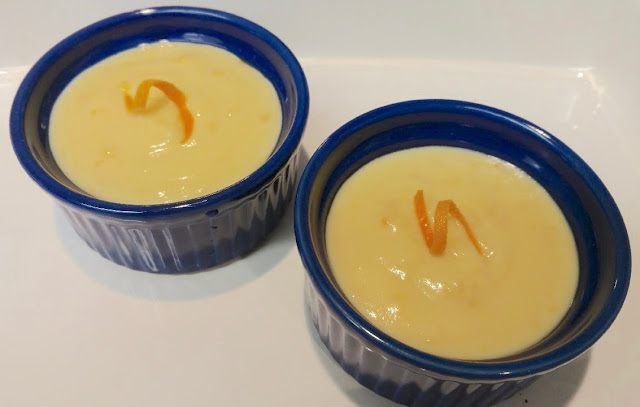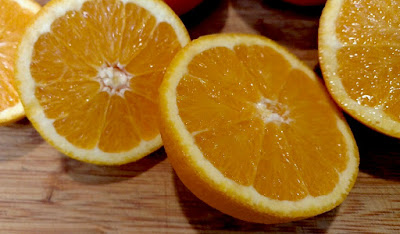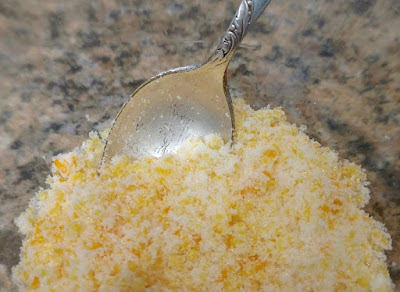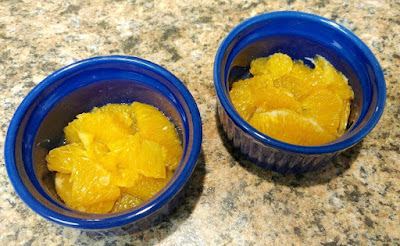
Recipe: Fresh orange custard boasts old-fashioned flavors

(Photos: Debbie Arrington) |

|
If you like the flavor of fresh oranges, this old-fashioned custard is for you.
I love fresh oranges, which is a good thing: We have backyard citrus trees and a steady supply of sweet winter fruit.
In search of more ways to enjoy oranges, I recalled that my grandmother occasionally made an orange pudding that could double as a pie filling; it wasn’t chiffon, it was custard.
While that specific recipe still eludes me, this one comes close. The orange segments (an idea borrowed from “Joy of Cooking”) give it a fresh taste, added texture and a lot more orange flavor. The fruit is like buried treasure hidden under the rich topping.
Take some extra time to “supreme” the orange segments. Remove all the fibrous membranes by slicing the fruit sections out instead of pulling the sections apart. The trick is to use a sharp knife and cut along each membrane where it meets the juice sacs. Forming a wedge, cut along one membrane; do the same on the other side of that segment. Then, pop the segment out. It’s handy to work over a bowl to catch the segments and juice. Or you can use a cutting board to steady the fruit.
The orange supremes look pretty at the bottom of a glass bowl topped by the silky custard speckled with orange zest.

|
Fresh orange custard
Makes 4 servings
Ingredients:
2 tablespoons orange zest
1/3 cup sugar
4 oranges
2 cups low-fat milk
¼ cup heavy cream
3 egg yolks
2 tablespoons cornstarch
1/2 teaspoon vanilla extract
Instructions:

The drained orange sections are spooned into the bottom
of the ramekins (or bowl).
|
Mix together orange zest and sugar. Set aside.
Over a large bowl, peel oranges with a sharp knife, cutting away the white pith and letting any juice collect in the bowl. Section the oranges supreme-style, slicing along the membranes; remove any seeds. Put the orange sections in the bowl and squeeze any remaining juice from the membranes over the sections. Set aside.
In a saucepan over medium heat, mix together milk and cream. Scald the milk (heating until little bubbles form around the edges), stirring often so it doesn’t stick.
Meanwhile, in the top of a double boiler, beat the egg yolks. Stir in the hot scalded milk.
Add cornstarch to the zest-sugar mixture; stir into custard. Stir in vanilla extract.
In the double boiler over medium heat, cook the custard until thickened, stirring often (it takes about 7 minutes). Remove from heat and let cool a few minutes.

Place spoonfuls of orange segments at the bottom of a glass dish or into individual ramekins. Spoon custard over the orange segments. Chill.
Comments
0 comments have been posted.Sacramento Digs Gardening to your inbox.
Sites We Like
Garden Checklist for week of July 21
Your garden needs you!
* Keep your vegetable garden watered, mulched and weeded. Water before 8 a.m. to reduce the chance of fungal infection and to conserve moisture.
* Feed vegetable plants bone meal, rock phosphate or other fertilizers high in phosphate to stimulate more blooms and fruiting. (But wait until daily high temperatures drop out of the 100s.)
* Don’t let tomatoes wilt or dry out completely. Give tomatoes a deep watering two to three times a week.
* Harvest vegetables promptly to encourage plants to produce more. Squash especially tends to grow rapidly in hot weather. Keep an eye on zucchini.
* Pinch back chrysanthemums for bushy plants and more flowers in September.
* Remove spent flowers from roses, daylilies and other bloomers as they finish flowering.
* Pinch off blooms from basil so the plant will grow more leaves.
* Cut back lavender after flowering to promote a second bloom.
* It's not too late to add a splash of color. Plant petunias, snapdragons, zinnias and marigolds.
* From seed, plant corn, pumpkins, radishes, winter squash and sunflowers.